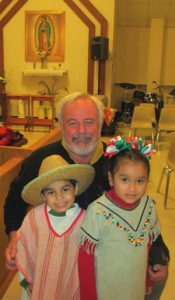Significance of the Stations of the Cross are not missed by the young
Some years ago, little three-year-old Jorge (George) brought this all home to me and my Marist brother, Fr. Paul Frechette S.M., in Callao, Peru. With much loving effort, and guided by Fr. Paul, the youth had prepared a script and special costumes for a Stations of the Cross in the shanty in which he lived. With the soldiers in their cardboard uniforms and the holy women, their eyes alight in their coiled round bed sheets and silk veils, the stations began in a broken-down park with few in attendance.
We entered the shanty of “San Judas Tadeo,” all the actors in the scene, and Christ with them, in fact one of them. From station to station we walked, sang and prayed, down the narrow muddy corridors wet and slushy from blocked drainage and leaking water works, walking, singing, praying in the darkness of the night—children, youths, adults, old people, accompanied by dogs and music and the sound of an angry sea battering the stone wall some 100 meters way.
In the darkness I felt a tiny hand grab mine. I looked down to find a small frizzy-haired boy with innocent shining eyes is meeting my gaze. He couldn’t have been more than three years old. “Are they going to nail him?” he asked. “It would seem so,” I replied. “Where are they going to nail him?” “Around the corner,” I assured him, while feeling the heat of his dirty little hand in mine.
“Around the corner?”
“Yes around the corner.”
“Are they going to nail him around the corner?”
“That’s right, when we get around the corner.”
We went around many corners, through the mud and in the darkness of the night, down corridors, up passageways, past roughly-built houses of timber or adobe brick. Sometimes a single naked electric light showed us the way. We stumbled one foot after the other. Each station was cared for by the family upon whose door it hung. Outside their home they had erected a small altar: a table, a picture or a statue of Jesus, the Virgin Mary or some saint. I continued to accompany the people with the little hand in mine “Are they going to nail him? Where are they going to nail him?” he kept asking.
We rounded the final corner and arrived at “Golgotha,” a crossing in the main street of the shanty. We were met by a crowd, replete with drunks, and cocaine sniffers. It was difficult to see the actors. We heard the sharp strikes of the hammer and I looked down and said to my little friend “I think they are nailing him.”
The little hand in mine moved and his voice rose up.
“Where are they nailing him? I can’t see a thing!”
I lifted the little one onto my shoulders. With his bare foot, coated with grime, almost in my mouth, little Jorge bent down and with a very serious and astonished look on his face said: “They have nailed him to the Cross.”
For Jorge, it was a blatant undeniable fact “They have nailed Christ to the Cross.”
Afterwards, in the little chapel during the veneration of the Cross, little Jorge, completely absorbed by the figure on the crucifix, went up at least three times to kiss Jesus, his feet, his side, his face.
Returning home that night, I asked myself why have we forgotten the signs and symbols? Why in the liturgies in our Churches, when we enact these events, do we not imbue them with the gripping core of the experience we are re-enacting? Why do we move through motions and miss what a poor, neglected child at the age of three can grasp and carry within fully?
[Source: “Today’s Marist”, published by the Society of Mary US Province.]

 Entries(RSS)
Entries(RSS)